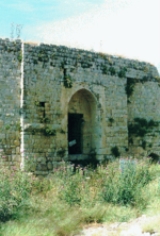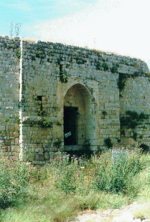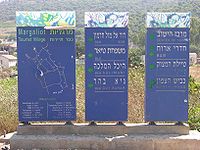
Margaliot
Encyclopedia
Margaliot is a moshav
in the Upper Galilee
in northern Israel
, located along the border with Lebanon
, near the town of Kiryat Shmona
. It is part of the Mevo'ot HaHermon Regional Council
. The settlement is home to approximately 400 residents, most of them Jews of Iranian Kurdistan
descent.

 Margaliot was established in 1951 on the site of the Lebanese
Margaliot was established in 1951 on the site of the Lebanese
town of Hunin, which is part of the Seven Lebanese Villages
across the Lebanese
/Israel
i border, by Jewish immigrants from Yemen
and Iraq
. The moshav was renamed after Chaim Margaliot Kalverisky, who headed the Jewish Colonization Association
in the Galilee
in the early twentieth century, and participated in the establishment of several Jewish settlements in the area. Today, neighboring Arab states (especially Lebanon), use the name Hunin to refer to the area covering moshav Margaliot and kibbutz
Misgav Am
.
Château Neuf (New Castle), a Crusader fortress, is situated by the road leading to the moshav.
Château Neuf provides a clear view of the Nimrod Fortress
and several other fortresses in the area.
The Syria
-Lebanon
-Palestine
boundary was a product of the post-World War I Anglo-French partition of Ottoman
Syria. British forces had advanced to a position at Tel Hazor against Turkish troops in 1918 and wished to incorporate all the sources of the Jordan River within British controlled Palestine. Following the Paris Peace Conference of 1919
, and the unratified and later annulled Treaty of Sèvres
, stemming from the San Remo conference
, the 1920 boundary extended the British controlled area to north of the Sykes Picot line, a straight line between the mid point of the Sea of Galilee
and Nahariya
. The international boundary between Palestine and Lebanon was finally agreed upon by Great Britain and France in 1923, in conjunction with the Treaty of Lausanne
, after Britain had been given a League of Nations
mandate for Palestine in 1922.
In April 1924, Hunin, along with seven other villages, and an estimated 20 other settlements, were transferred from the French Mandate of Lebanon
to the British mandate of Palestine by France
. Margaliot (Hunin) was claimed by Britain's Zionist allies; while, after the independence of Lebanon, the new Lebanese government asked for the return of this village and the rest of the villages and settlements. As of today, the Lebanese government still demands the return of these lands.
s of Hunin and some other Shi'ite villages met with the Jews of kibbutz Kfar Giladi
to try to make a peace agreement with the state of Israel. They promised to live as loyal citizens (minority under Jewish rule) and renounce Arab national aspirations. With the support of the local Jews, a report was made by the Department of Minorities recommending that such an agreement be reached with the 4,700 or so Shi'ites in the region to promote friendly relations with southern Lebanon, to take advantage of the Shi'ites' poor relationship with the majority Sunnis, and to enhance the prospect of a future extension of the border. This proposal was not accepted, despite the support of the minorities minister Bekhor Shitreet.
In August, more inhabitants of Hunin were forced to flee by the IDF. On September the 3rd 1948, the IDF raided the village blowing up 20 houses, killing a son of the mukhtar and 19 others and expelling the remaining villagers.
Moshav
Moshav is a type of Israeli town or settlement, in particular a type of cooperative agricultural community of individual farms pioneered by the Labour Zionists during the second aliyah...
in the Upper Galilee
Galilee
Galilee , is a large region in northern Israel which overlaps with much of the administrative North District of the country. Traditionally divided into Upper Galilee , Lower Galilee , and Western Galilee , extending from Dan to the north, at the base of Mount Hermon, along Mount Lebanon to the...
in northern Israel
Israel
The State of Israel is a parliamentary republic located in the Middle East, along the eastern shore of the Mediterranean Sea...
, located along the border with Lebanon
Lebanon
Lebanon , officially the Republic of LebanonRepublic of Lebanon is the most common term used by Lebanese government agencies. The term Lebanese Republic, a literal translation of the official Arabic and French names that is not used in today's world. Arabic is the most common language spoken among...
, near the town of Kiryat Shmona
Kiryat Shmona
Kiryat Shmona is a city located in the North District of Israel on the western slopes of the Hula Valley on the Lebanese border. The city was named for the eight people, including Joseph Trumpeldor, who died in 1920 defending Tel Hai....
. It is part of the Mevo'ot HaHermon Regional Council
Mevo'ot HaHermon Regional Council
Mevo'ot HaHermon Regional Council is a Regional Council in the North District of Israel. It encompasses 13 Moshavim and Communal settlements, from the northern shore of the Kinneret, to the Lebanese border and Mount Hermon...
. The settlement is home to approximately 400 residents, most of them Jews of Iranian Kurdistan
Iranian Kurdistan
Iranian Kurdistan is an unofficial name for the parts of Iran inhabited by Kurds and has borders with Iraq and Turkey. It includes Kurdistan Province, Kermanshah Province, Ilam Province and parts of West Azerbaijan province....
descent.
History


Lebanon
Lebanon , officially the Republic of LebanonRepublic of Lebanon is the most common term used by Lebanese government agencies. The term Lebanese Republic, a literal translation of the official Arabic and French names that is not used in today's world. Arabic is the most common language spoken among...
town of Hunin, which is part of the Seven Lebanese Villages
Seven Lebanese Villages
The Seven Lebanese Villages refers to the seven Lebanese villages of Tarbikha, Saliha, Malkiyeh, Nabi Yusha, Qadas, Hunin, and Abil al-Qamh located in what is today Northern Israel...
across the Lebanese
Lebanon
Lebanon , officially the Republic of LebanonRepublic of Lebanon is the most common term used by Lebanese government agencies. The term Lebanese Republic, a literal translation of the official Arabic and French names that is not used in today's world. Arabic is the most common language spoken among...
/Israel
Israel
The State of Israel is a parliamentary republic located in the Middle East, along the eastern shore of the Mediterranean Sea...
i border, by Jewish immigrants from Yemen
Yemen
The Republic of Yemen , commonly known as Yemen , is a country located in the Middle East, occupying the southwestern to southern end of the Arabian Peninsula. It is bordered by Saudi Arabia to the north, the Red Sea to the west, and Oman to the east....
and Iraq
Iraq
Iraq ; officially the Republic of Iraq is a country in Western Asia spanning most of the northwestern end of the Zagros mountain range, the eastern part of the Syrian Desert and the northern part of the Arabian Desert....
. The moshav was renamed after Chaim Margaliot Kalverisky, who headed the Jewish Colonization Association
Jewish Colonization Association
The Jewish Colonization Association was created on September 11, 1891 by the Baron Maurice de Hirsch. Its aim was to facilitate the mass emigration of Jews from Russia and other Eastern European countries, by settling them in agricultural colonies on lands purchased by the committee, particularly...
in the Galilee
Galilee
Galilee , is a large region in northern Israel which overlaps with much of the administrative North District of the country. Traditionally divided into Upper Galilee , Lower Galilee , and Western Galilee , extending from Dan to the north, at the base of Mount Hermon, along Mount Lebanon to the...
in the early twentieth century, and participated in the establishment of several Jewish settlements in the area. Today, neighboring Arab states (especially Lebanon), use the name Hunin to refer to the area covering moshav Margaliot and kibbutz
Kibbutz
A kibbutz is a collective community in Israel that was traditionally based on agriculture. Today, farming has been partly supplanted by other economic branches, including industrial plants and high-tech enterprises. Kibbutzim began as utopian communities, a combination of socialism and Zionism...
Misgav Am
Misgav Am
Misgav Am is a kibbutz in the Upper Galilee in northern Israel. Located close to the border with Lebanon near the town of Kiryat Shmona, it falls under the jurisdiction of Upper Galilee Regional Council....
.
Château Neuf (New Castle), a Crusader fortress, is situated by the road leading to the moshav.
Château Neuf provides a clear view of the Nimrod Fortress
Nimrod Fortress
The Nimrod Fortress or Nimrod's Fortress, is a medieval fortress situated in the northern Golan Heights, on a ridge rising about 800 m above sea level.-History:...
and several other fortresses in the area.
The Syria
Syria
Syria , officially the Syrian Arab Republic , is a country in Western Asia, bordering Lebanon and the Mediterranean Sea to the West, Turkey to the north, Iraq to the east, Jordan to the south, and Israel to the southwest....
-Lebanon
Lebanon
Lebanon , officially the Republic of LebanonRepublic of Lebanon is the most common term used by Lebanese government agencies. The term Lebanese Republic, a literal translation of the official Arabic and French names that is not used in today's world. Arabic is the most common language spoken among...
-Palestine
Palestine
Palestine is a conventional name, among others, used to describe the geographic region between the Mediterranean Sea and the Jordan River, and various adjoining lands....
boundary was a product of the post-World War I Anglo-French partition of Ottoman
Ottoman Empire
The Ottoman EmpireIt was usually referred to as the "Ottoman Empire", the "Turkish Empire", the "Ottoman Caliphate" or more commonly "Turkey" by its contemporaries...
Syria. British forces had advanced to a position at Tel Hazor against Turkish troops in 1918 and wished to incorporate all the sources of the Jordan River within British controlled Palestine. Following the Paris Peace Conference of 1919
Paris Peace Conference, 1919
The Paris Peace Conference was the meeting of the Allied victors following the end of World War I to set the peace terms for the defeated Central Powers following the armistices of 1918. It took place in Paris in 1919 and involved diplomats from more than 32 countries and nationalities...
, and the unratified and later annulled Treaty of Sèvres
Treaty of Sèvres
The Treaty of Sèvres was the peace treaty between the Ottoman Empire and Allies at the end of World War I. The Treaty of Versailles was signed with Germany before this treaty to annul the German concessions including the economic rights and enterprises. Also, France, Great Britain and Italy...
, stemming from the San Remo conference
San Remo conference
The San Remo Conference was an international meeting of the post-World War I Allied Supreme Council, held in Sanremo, Italy, from 19 to 26 April 1920. It was attended by the four Principal Allied Powers of World War I who were represented by the prime ministers of Britain , France and Italy and...
, the 1920 boundary extended the British controlled area to north of the Sykes Picot line, a straight line between the mid point of the Sea of Galilee
Sea of Galilee
The Sea of Galilee, also Kinneret, Lake of Gennesaret, or Lake Tiberias , is the largest freshwater lake in Israel, and it is approximately in circumference, about long, and wide. The lake has a total area of , and a maximum depth of approximately 43 m...
and Nahariya
Nahariya
Nahariya is the northernmost coastal city in Israel, with an estimated population of 51,200.-History:Nahariya was founded by German Jewish immigrants from the Fifth Aliyah in the 1930s...
. The international boundary between Palestine and Lebanon was finally agreed upon by Great Britain and France in 1923, in conjunction with the Treaty of Lausanne
Treaty of Lausanne
The Treaty of Lausanne was a peace treaty signed in Lausanne, Switzerland on 24 July 1923, that settled the Anatolian and East Thracian parts of the partitioning of the Ottoman Empire. The treaty of Lausanne was ratified by the Greek government on 11 February 1924, by the Turkish government on 31...
, after Britain had been given a League of Nations
League of Nations
The League of Nations was an intergovernmental organization founded as a result of the Paris Peace Conference that ended the First World War. It was the first permanent international organization whose principal mission was to maintain world peace...
mandate for Palestine in 1922.
In April 1924, Hunin, along with seven other villages, and an estimated 20 other settlements, were transferred from the French Mandate of Lebanon
French Mandate of Lebanon
The state of Greater Lebanon, the predecessor of modern Lebanon, was created in 1920 as part of the French scheme of dividing the French Mandate of Syria into six states....
to the British mandate of Palestine by France
France
The French Republic , The French Republic , The French Republic , (commonly known as France , is a unitary semi-presidential republic in Western Europe with several overseas territories and islands located on other continents and in the Indian, Pacific, and Atlantic oceans. Metropolitan France...
. Margaliot (Hunin) was claimed by Britain's Zionist allies; while, after the independence of Lebanon, the new Lebanese government asked for the return of this village and the rest of the villages and settlements. As of today, the Lebanese government still demands the return of these lands.
Events of 1948
Hunin was a Shi'ite Muslim village with a population of 1620 recorded in 1945. A Palmach raid in May 1948 led to many of the inhabitants fleeing to Lebanon, leaving 400 remaining in the village. During a meeting in August 1948, when only 400 villagers remained in Hunin, the mukhtarMukhtar
Mukhtar meaning "chosen" in Arabic, refers to the head of a village or mahalle in many Arab countries as well as in Turkey and Cyprus. The name refers to the fact that mukhtars are usually selected by some consensual or participatory method, often involving an election. Mukhtar is also a common...
s of Hunin and some other Shi'ite villages met with the Jews of kibbutz Kfar Giladi
Kfar Giladi
-External links:* * Jewish Agency for Israel*...
to try to make a peace agreement with the state of Israel. They promised to live as loyal citizens (minority under Jewish rule) and renounce Arab national aspirations. With the support of the local Jews, a report was made by the Department of Minorities recommending that such an agreement be reached with the 4,700 or so Shi'ites in the region to promote friendly relations with southern Lebanon, to take advantage of the Shi'ites' poor relationship with the majority Sunnis, and to enhance the prospect of a future extension of the border. This proposal was not accepted, despite the support of the minorities minister Bekhor Shitreet.
In August, more inhabitants of Hunin were forced to flee by the IDF. On September the 3rd 1948, the IDF raided the village blowing up 20 houses, killing a son of the mukhtar and 19 others and expelling the remaining villagers.
See also
- List of Arab towns and villages depopulated during the 1948 Arab-Israeli War
- Metawali
- Seven Lebanese VillagesSeven Lebanese VillagesThe Seven Lebanese Villages refers to the seven Lebanese villages of Tarbikha, Saliha, Malkiyeh, Nabi Yusha, Qadas, Hunin, and Abil al-Qamh located in what is today Northern Israel...
External links
- Welcome to Hunin
- Hunin, at Khalil Sakakini Cultural CenterKhalil Sakakini Cultural CenterKhalil Sakakini Cultural Center is an organization established in 1996. It is located at 4 Raja Street, Ramallah in the West Bank. The traditional manor that houses the centre was the former family home of Khalil Salem Salah, the mayor of Ramallah between 1947/1951, is now owned by the Palestinian...
- Hunin, by Dr. Khalil Rizk.

